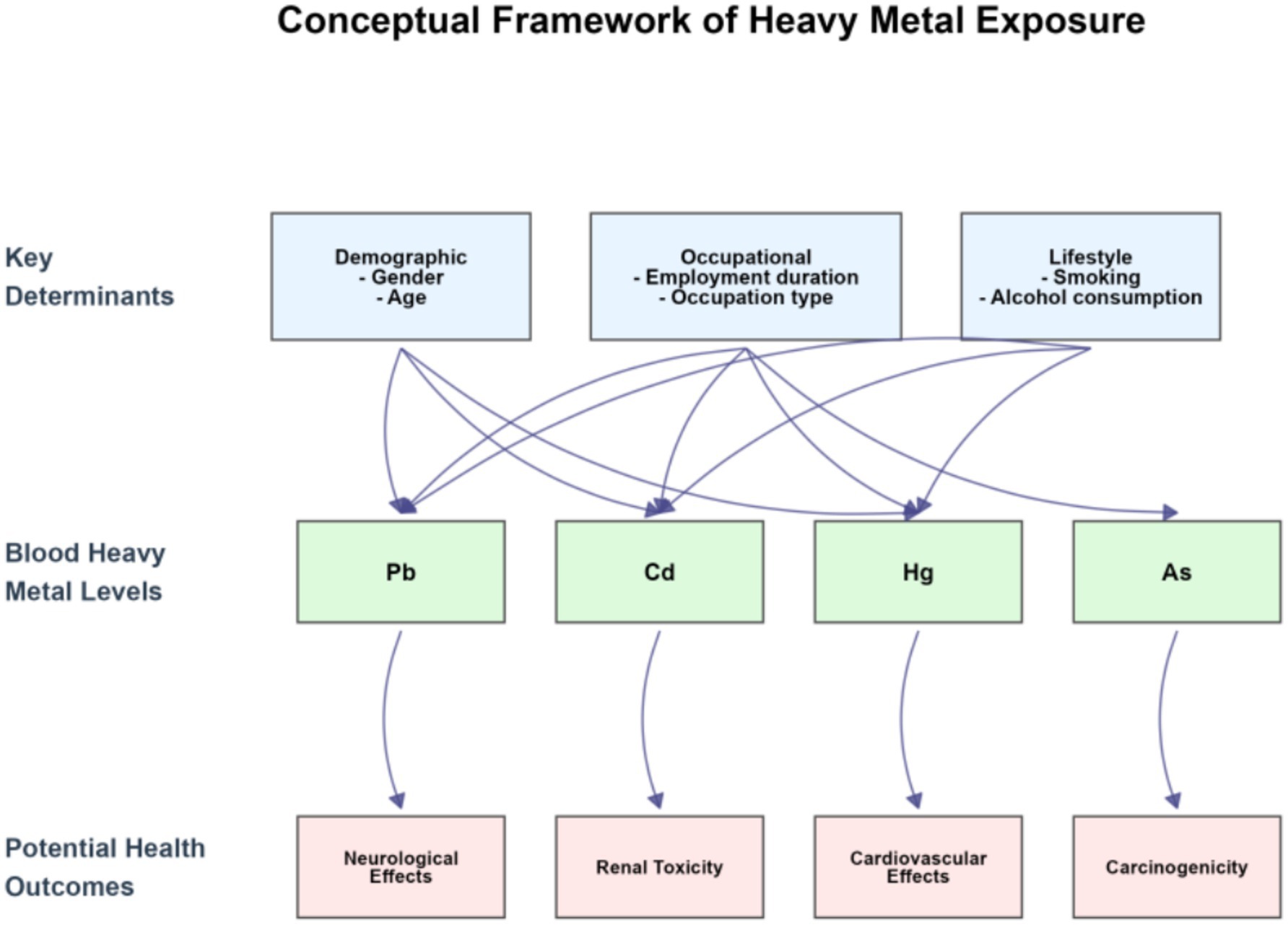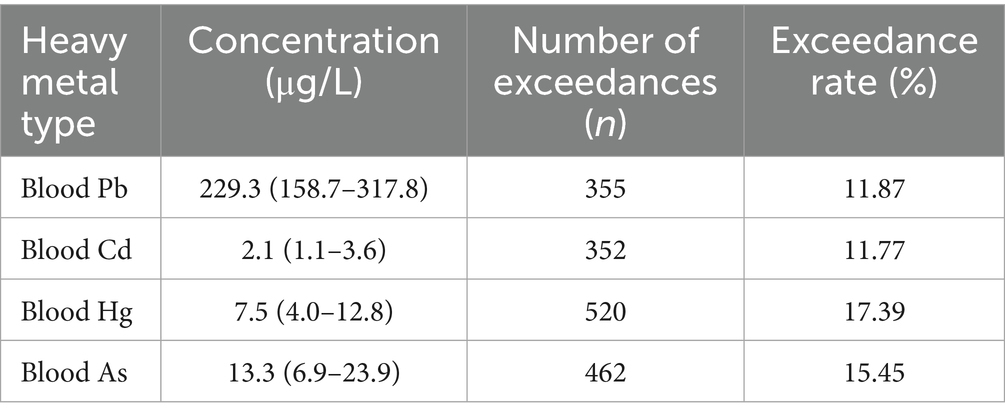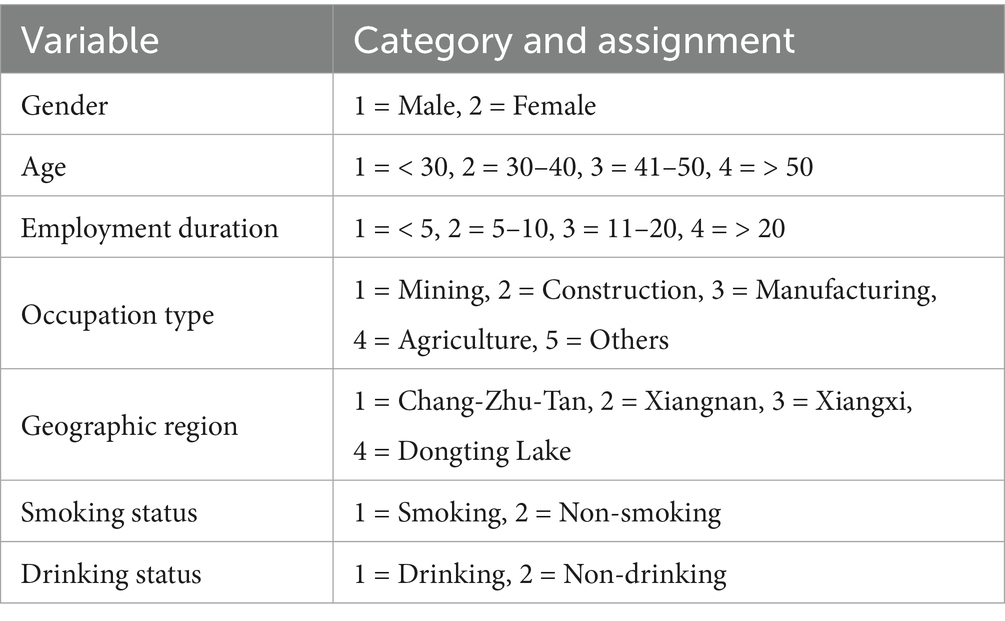- 1Public Health and Preventive Medicine, Wuhan University of Science and Technology, Wuhan, China
- 2Central Laboratory, Hunan Prevention and Treatment Institute for Occupational Diseases, Changsha, China
Objective: This study aims to characterize current whole blood levels of heavy metals including lead (Pb), cadmium (Cd), mercury (Hg), and arsenic (As) among occupational populations in Hunan Province, China, and identify exposure determinants to inform health management strategies.
Methods: A cross-sectional study was conducted on 2,991 occupational workers. Demographic data, occupational exposure history, and lifestyle habits were collected. Whole blood samples were analyzed via atomic absorption spectrophotometry for Pb and Cd levels, and atomic fluorescence spectrophotometry for Hg and As concentrations. Multiple linear regression was used to identify exposure predictors, and K-means clustering to categorize exposure patterns.
Results: Elevated exceedance rates were observed for all metals, with Hg showing the highest rate (17.39%). Significantly higher blood metal levels (p < 0.05) were associated with males, age > 50 years, employment duration > 20 years, mining occupations, residence in Chang-Zhu-Tan, smoking, and drinking. Regression analyses revealed gender, age, employment duration, occupation type, and smoking as significant predictors of Pb and Cd levels (p < 0.05); gender, age, employment duration, and drinking for Hg (p < 0.05); and gender, age, employment duration, occupation type, and geographic region for As (p < 0.05). K-means clustering stratified participants into low-, medium-, and high-exposure groups, with the latter exhibiting markedly elevated metal levels (p < 0.05), including some samples exceeding occupational exposure limits.
Conclusion: Whole blood heavy metal levels in Hunan occupational populations are significantly influenced by gender, age, employment duration, occupation type, and geographic factors. Targeted exposure mitigation and enhanced biomonitoring are urgently needed for high-risk subgroups.
1 Introduction
Heavy metal pollution has emerged as a global environmental and public health challenge driven by rapid industrialization and urbanization. Characterized by persistence, bioaccumulation, and high toxicity, heavy metals such as lead (Pb), cadmium (Cd), mercury (Hg), and arsenic (As) infiltrate human systems through atmospheric, aquatic, and terrestrial pathways, posing severe health threats (1, 2). Cumulative evidence indicates that occupational populations chronically exposed to these metals may face elevated risks of neurological impairment, renal dysfunction, cardiovascular disorders, and even carcinogenesis (3). For instance, an increase in blood Pb levels is closely related to cognitive decline and anemia (4). Exposure to Cd can cause renal damage and bone diseases (5). Higher blood Hg levels are associated with neurotoxicity and an elevated risk of cardiovascular diseases (6). Blood As exposure is linked to various diseases like skin lesions and cancers (7). Notably, occupational cohorts always exhibit higher blood metal burdens due to prolonged workplace exposure, correlating with increased morbidity and mortality rates in epidemiological studies (8).
Despite advancements in assessing occupational heavy metal exposure and its influencing factors, existing research remains fragmented by its focus on single industries or localized regions. Comprehensive evaluations integrating multi-metal co-exposure analyses and influencing factors are limited. This gap is particularly relevant in Hunan Province, a pivotal industrial hub in China with a substantial workforce engaged in mining, manufacturing, and construction. Inadequate environmental safeguards and insufficient occupational protection awareness have exacerbated heavy metal exposure risks among these populations (9, 10). Although efforts for occupational disease prevention have intensified in recent years, systematic investigations into whole blood heavy metal levels across diverse occupational groups remain sparse, particularly regarding multi-metal assessments and mechanistic exploration of influencing factors.
This study aims to investigate the distribution patterns of whole blood heavy metals (Pb, Cd, Hg, As) among occupationally exposed populations in Hunan Province and elucidate determinants spanning demographic traits, occupational exposure characteristics, and lifestyle behaviors. By integrating multi-metal biomonitoring with multivariate analysis, our findings will clarify regional exposure profiles and inform evidence-based occupational health strategies. These efforts align with national objectives to mitigate workplace hazards and advance the implementation of occupational disease prevention and control frameworks.
To intuitively present the core logic of “heavy metal exposure among occupational populations” that this study focuses on, we constructed a conceptual framework diagram of heavy metal exposure (Figure 1), which clearly sorts out the association chain of “key determining factors → whole - blood heavy metal levels → potential health outcomes.” Among them, demographic characteristics such as gender and age, occupational attributes such as employment duration and occupation type, and lifestyle habits such as smoking and alcohol consumption constitute the key determining factors of exposure; these factors affect the levels of heavy metals such as Pb, Cd, Hg, and As in whole blood through pathways like occupational contact and environmental exposure; and the long - term accumulation of heavy metals may induce health hazards such as neurotoxicity, nephrotoxicity, cardiovascular damage, and carcinogenicity.
2 Materials and method
2.1 Study population
This study employed stratified random sampling to recruit participants. Based on the industry demographics published by the Hunan Provincial Bureau of Statistics, the occupational populations were stratified by occupation type (mining, construction, manufacturing, agriculture, and others) and geographic region (Chang-Zhu-Tan, Xiangnan, Xiangxi, Dongting Lake). Within each stratum, participating enterprises were randomly selected from official registries, and employees were further randomly sampled within enterprises according to employment duration and gender distributions. Ultimately, 2,991 participants were enrolled for a cross-sectional survey, with sample characteristics closely reflecting the occupational structure of Hunan Province to ensure representativeness. Eligible participants met the following inclusion criteria: (1) age ≥ 18 years with current employment in recognized occupational sectors across Hunan Province; and (2) minimum employment duration of 1 year in their current position. Exclusion criteria comprised: (1) pre-existing chronic conditions affecting heavy metal metabolism (hematological disorders, renal dysfunction, or hepatic diseases); (2) history of heavy metal chelation therapy or use of medications known to influence heavy metal metabolism within 3 months prior to enrollment; and (3) pregnancy, lactation, or childhood. The study protocol received ethical approval from the Hunan Prevention and Treatment Institute for Occupational Diseases (Approval No. 2025051301).
2.2 Study methods
Demographic characteristics (gender, age, employment duration), occupational exposure profiles (occupation type, geographic region), and lifestyle factors (smoking status, drinking status) were retrospectively extracted from historical physical examination records. Concurrently, whole blood samples were collected from participants for quantification of blood Pb, Cd, Hg, and As concentrations.
2.3 Data and specimen collection
Certified healthcare professionals collected 5 mL of antecubital venous blood from each participant. Blood samples were immediately transferred to anticoagulant-containing vacuum tubes, gently inverted to ensure proper mixing, and stored at 2–8°C. All specimens were processed within 24 h to minimize pre-analytical variability. Quantification of whole blood heavy metal concentrations was performed using atomic absorption spectrophotometry (11) for Pb and Cd, and atomic fluorescence spectrophotometry (12) for Hg and As.
2.4 K-means cluster analysis
K-means cluster analysis, an unsupervised machine learning algorithm, was employed to classify occupational populations based on whole blood heavy metal exposure profiles. Blood Pb, Cd, Hg, and As concentrations were selected as clustering variables, with raw data normalized. The optimal cluster number was determined using the Elbow method, which identified a definitive inflection point at k = 3. Participants were subsequently stratified into three distinct exposure categories: Low-exposure cluster: Characterized by blood concentrations below occupational exposure limits (OELs) for all metals (Pb ≤ 200 μg/L, Cd ≤ 2 μg/L, Hg ≤ 5 μg/L, and As ≤ 10 μg/L). Medium-exposure cluster: Defined by ≥ 1 parameter meeting or marginally exceeding OELs (Pb 200–400 μg/L, Cd 2–5 μg/L, Hg 5–15 μg/L, and As 10–30 μg/L). High-exposure cluster: Comprising participants with ≥ 1 parameter substantially exceeding OELs (Pb > 400 μg/L, Cd > 5 μg/L, Hg > 15 μg/L, and/or As > 30 μg/L).
2.5 Statistical analysis
Data processing and statistical analyses were conducted using SPSS Statistics 26.0 and R programming language. After normality assessment, normally distributed continuous variables were expressed as mean ± standard deviation (x̄ ± s) and analyzed using independent samples t-tests (two-group comparisons) or one-way analysis of variance (ANOVA), with LSD-t test for pairwise comparisons or Tukey’s method for correction. Non-normally distributed variables were reported as median with interquartile range [M (P25, P75)] and evaluated via Mann–Whitney U tests or Kruskal-Wallis rank sum tests. Categorical variables were presented as n (%) and compared using χ2 tests or Fisher’s exact probability tests as appropriate. Multivariate linear regression models were constructed to assess the independent effects of key predictors, including gender, age, employment duration, occupation type, geographic region, smoking status, and drinking status, on whole blood heavy metal levels. All covariates were simultaneously included in the fully adjusted models. K-means clustering was used to quantify exposure pattern heterogeneity. A p-value < 0.05 was considered statistically significant.
3 Results
3.1 Current status of whole blood heavy metals in occupational populations
A cohort of 2,991 occupationally exposed individuals was analyzed for whole blood concentrations of Pb, Cd, Hg, and As. The results revealed significant exceedance of OELs for all four heavy metals, with blood Hg demonstrating the highest exceedance rate (Table 1). These findings highlight substantial exposure risks that need targeted mitigation strategies in high-risk occupational environments.
3.2 Comparison of whole blood heavy metal levels across demographic subgroups
Demographic stratification of the occupational cohort (n = 2,991) demonstrated the following distributions: gender (male: n = 1,521; female: n = 1,470), age (< 30 years: n = 763; 30–40 years: n = 768; 41–50 years: n = 705; > 50 years: n = 755), employment duration (< 5 years: n = 762; 5–10 years: n = 770; 11–20 years: n = 717; > 20 years: n = 742), occupation type (mining: n = 626; construction: n = 597; manufacturing: n = 537; agriculture: n = 625; others: n = 606), geographic region (Chang-Zhu-Tan: n = 799; Xiangnan: n = 745; Xiangxi: n = 727; Dongting Lake: n = 720), smoking status (smoking: n = 1,468; non-smoking: n = 1,523), and drinking status (drinking: n = 1,485; non-drinking: n = 1,506).
In the gender subgroups, males had significantly higher levels of blood Pb, Cd, Hg, and As compared with females (p < 0.05; Figure 2A). Age-based subgroup analysis indicated that the levels of heavy metals increased with age, with the > 50-year group showing the highest levels (p < 0.05; Figure 2B). As for employment duration, longer employment was associated with higher levels of blood Pb, Cd, Hg, and As, with maximal levels in the > 20-year group (p < 0.05; Figure 2C). Among occupational categories, mining workers exhibited the highest Pb, Cd, Hg, and As levels, while agricultural workers showed peak blood Hg concentrations (p < 0.05; Figure 2D). Geographically, the highest blood Pb levels were observed in Chang-Zhu-Tan, Cd in Dongting Lake, Hg in Xiangnan, and As in Xiangxi (p < 0.05; Figure 2E). In terms of lifestyle behaviors, smokers had increased blood Pb and Cd compared with non-smokers, while drinkers demonstrated higher blood Hg levels than non-drinkers (p < 0.05; Figures 2F,G).
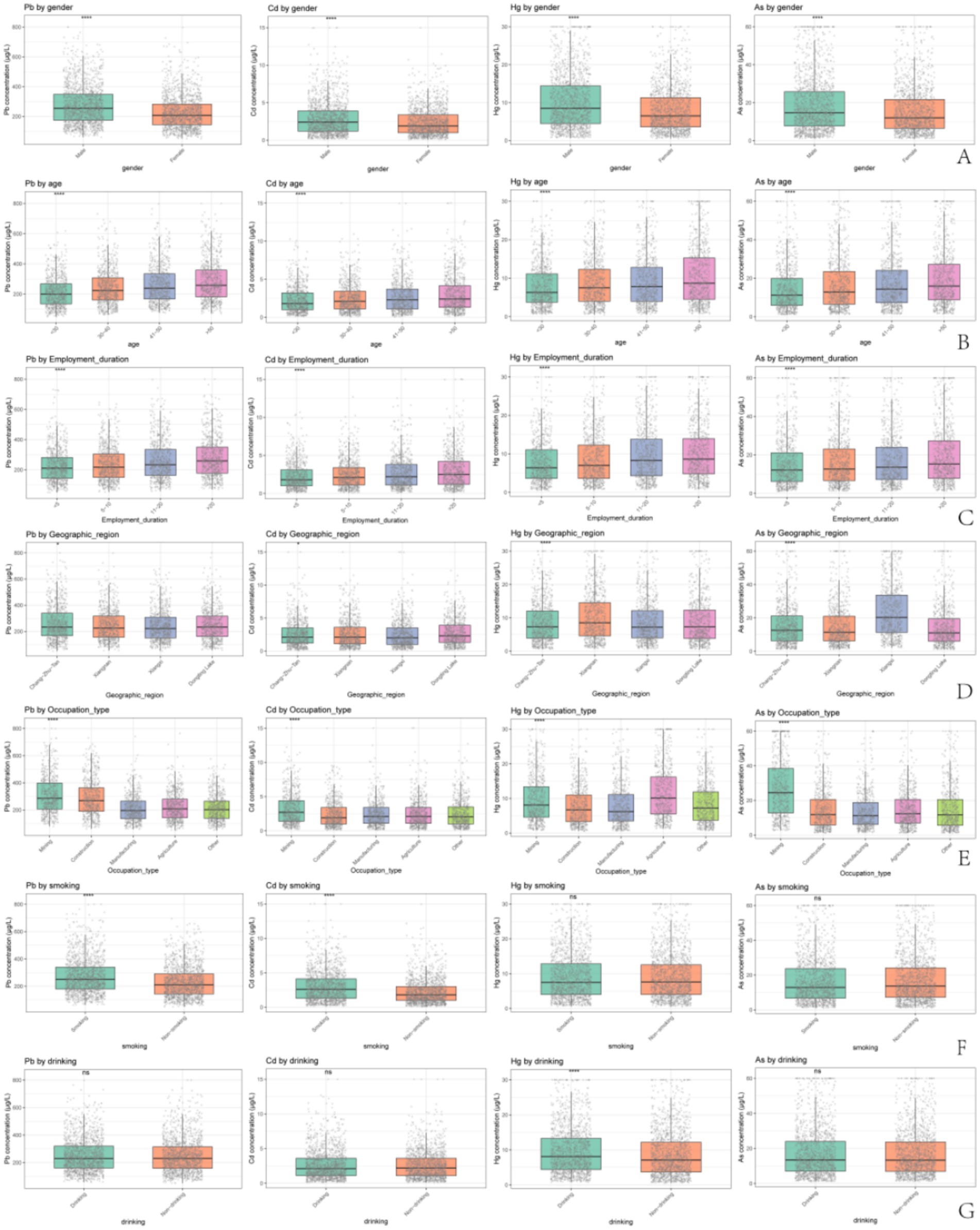
Figure 2. Comparative whole blood heavy metal concentrations across demographic subgroups. (A) Comparison of blood lead, cadmium, mercury, and arsenic levels between male and female participants. (B) Comparison of heavy metal levels across age groups (< 30, 30–40, 41–50, > 50 years). (C) Comparison of heavy metal levels across employment duration groups (< 5, 5–10, 11–20, > 20 years). (D) Comparison of heavy metal levels across occupational categories (mining, construction, manufacturing, agriculture, others). (E) Comparison of heavy metal levels across geographic regions (Chang-Zhu-Tan, Xiangnan, Xiangxi, Dongting Lake). (F) Comparison of heavy metal levels between smokers and non-smokers. (G) Comparison of heavy metal levels between drinkers and non-drinkers. ns = non-significant (p > 0.05), * = p < 0.05; **** = p < 0.0001.
The geographic distribution map confirms that heavy metal exposure is not uniformly distributed but rather tied to regional industrial and environmental characteristics, reinforcing the role of geographic factors as key determinants of occupational exposure (Figures 3A–D).
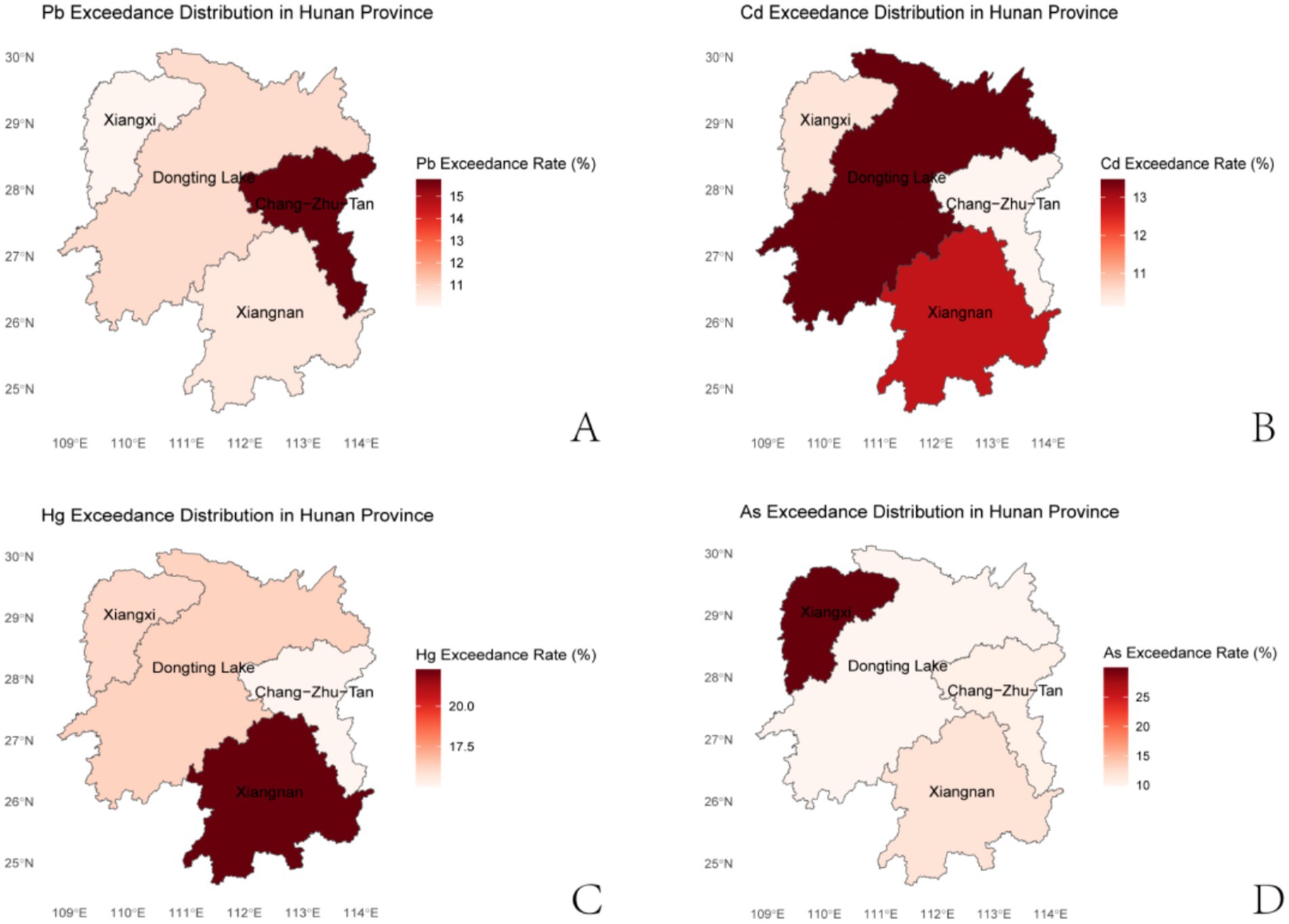
Figure 3. Geographic distribution map of heavy metal exposure (Hunan Province). Panel (A–D) represent the spatial differences in the average exceedance rates of key heavy metals (Pb, Hg, Cd, As) in whole blood across Chang-Zhu-Tan, Xiangnan, Xiangxi, and Dongting Lake regions, respectively. The color gradient reflects the magnitude of exceedance rates (low to high), with data derived from the statistical analysis of 2,991 occupational participants. Regional boundaries are based on administrative divisions of Hunan Province, and the distribution patterns correspond to localized industrial activities and environmental pollution sources.
3.3 Multivariate linear regression analysis of determinants influencing whole blood heavy metal levels
Separate multivariate linear regression models evaluated demographic, occupational, and behavioral covariates (categorized in Table 2) as independent predictors of whole blood Pb, Cd, Hg, and As concentrations. The regression models identified gender, age, employment duration, occupation type, and smoking status as significant determinants of blood Pb levels (p < 0.05; Table 3). Similarly, blood Cd concentrations were independently associated with gender, age, employment duration, occupation type, and smoking status (p < 0.05; Table 4). For blood Hg, significant predictors included gender, age, employment duration, and drinking status (p < 0.05; Table 5), whereas blood As levels were significantly influenced by gender, age, employment duration, occupation type, and geographic region (p < 0.05; Table 6).
3.4 K-means clustering-based typology of occupational blood heavy metal exposure
Utilizing the K-means clustering algorithm, we stratified the occupational cohort into three distinct exposure archetypes: low-exposure (n = 93, 3.1%), medium-exposure (n = 1,614, 54.0%), and high-exposure clusters (n = 1,284, 42.9%). The high-exposure cluster exhibited substantially elevated blood concentrations of Pb, Cd, Hg, and As, with all participants exceeding OELs for at least one metal. In contrast, the low-exposure cluster demonstrated minimal exposure burdens of Pb, Cd, Hg, and As, with all parameters remaining far below OELs. The medium-exposure cluster displayed intermediate profiles, where some individuals approached or marginally surpassed OELs (Table 7). Radar plot visualization (Figure 4) further delineated the inter-cluster divergence in heavy metal exposure profiles.
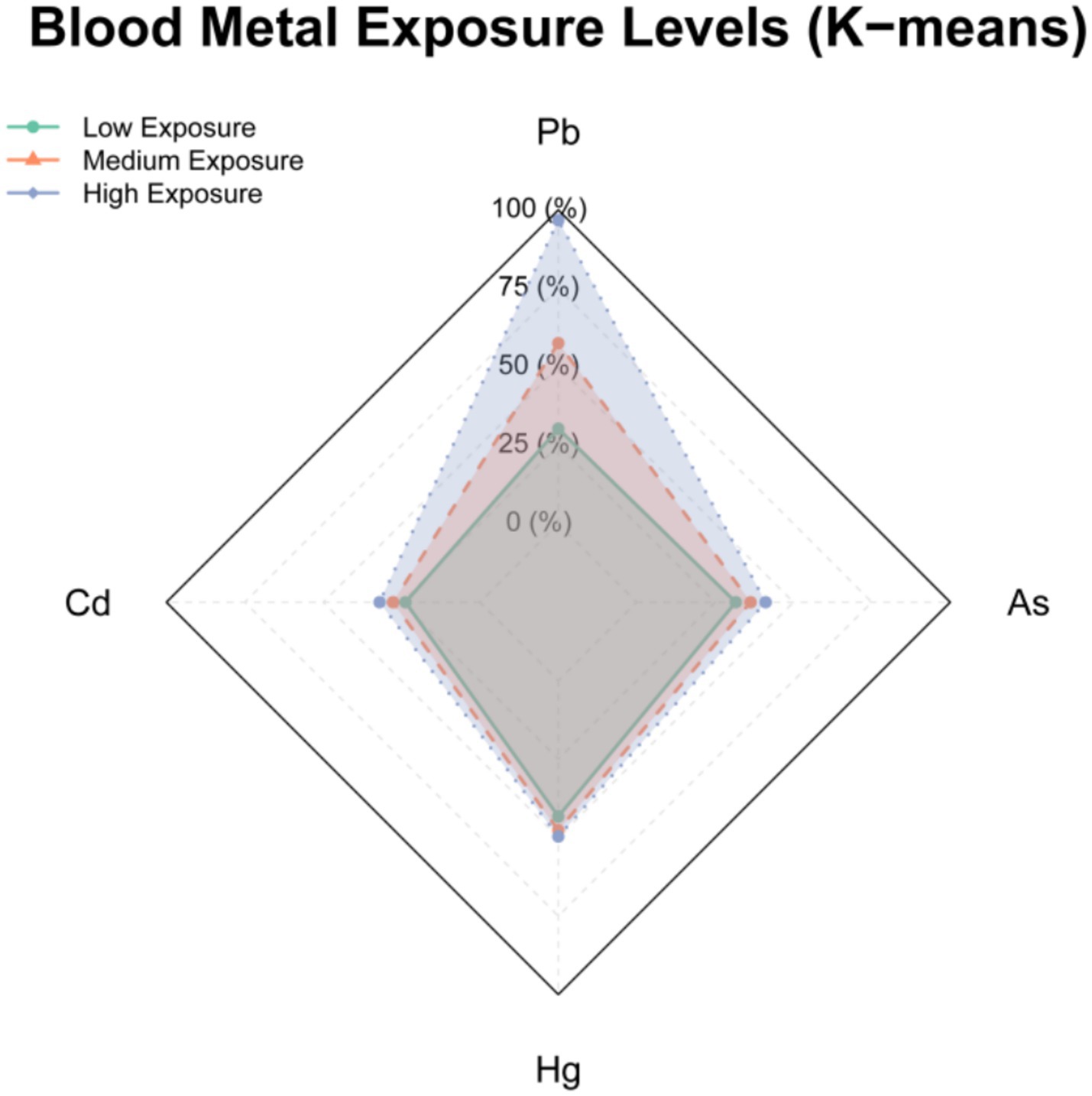
Figure 4. Radar plot illustrating whole blood heavy metal exposure profiles of occupational clusters based on K-means clustering.
4 Discussion
Heavy metals, commonly including Pb, Cd, Hg, and As, represent a class of elements with significant toxicological potential and widely present in natural environments and industrial processes. These metals enter the human body through inhalation, ingestion, and dermal contact, bioaccumulating in tissues and organs. Prolonged exposure can cause damage to the nervous system, kidneys, cardiovascular system, and immune system, and may even induce carcinogenesis (13). Occupational populations, particularly those engaged in mining, manufacturing, and construction, face disproportionate exposure risks due to inhalation of metal-laden particulates, dermal contact with contaminated surfaces, and ingestion of tainted water or food (14). Industrial processes such as smelting, metal refining, battery production, and chemical production exacerbate workplace contamination, resulting in elevated blood metal concentrations among workers compared to the general population. Studies have demonstrated that occupational exposure not only correlates with elevated heavy metal burden but also exacerbates risks of hypertension, renal dysfunction, neurological disorders, and malignancies (15, 16). In Hunan Province, a pivotal industrial hub in central-south China, diverse industries and complex occupational environments amplify heavy metal exposure risks, necessitating systematic investigations on the current status and influencing factors of heavy metal exposure among occupational populations in this region to inform targeted interventions.
This study found that whole blood heavy metal levels among the occupational populations in Hunan Province exhibited significant differences, with higher levels observed in males, individuals aged > 50 years, and those with employment duration > 20 years, particularly pronounced in the mining and manufacturing industries. These findings are generally consistent with global epidemiological trends. For example, a study on smelter workers reported that longer employment duration and male sex were associated with significantly higher blood Pb levels (17), which may be attributable to the cumulative effect of prolonged occupational exposure and sex-related differences in metal metabolism (18). Similarly, an epidemiological investigation on battery factories in low- and middle-income countries identified employment duration and sex as important determinants of blood Pb and Cd levels (19), suggesting broad applicability of these risk factors. However, some studies did not find a significant sex difference, which might be explained by differences in sample composition, a higher proportion of females in high-risk positions, or variations in detection methods (20). The results of our study facilitate the identification and targeted intervention of susceptible populations at the regional level.
In our study, mining workers exhibited significantly elevated blood Pb, Cd, and As levels, consistent with their occupational exposure characteristics. Processes including ore extraction, crushing, and transportation generate dust and wastewater containing Pb, Cd, and As, which enter the body via inhalation and dermal contact and bioaccumulate over time. This exposure pathway is well documented in prior occupational studies (21). Conversely, agricultural workers showed higher blood Hg levels, potentially reflecting residual mercury-based pesticides and contaminated irrigation water and crops in some areas (22). Additionally, elevated blood Hg among drinkers may originate from homemade alcohol production using mercury-contaminated containers in rural regions (23), indicating the role of lifestyle factors in exposure modulation.
Significant regional differences were also observed: higher blood Pb in Chang-Zhu-Tan, elevated Hg in Xiangnan, increased Cd in Dongting Lake, and higher As in Xiangxi. These patterns correspond to localized industrial activities and pollution sources. Chang-Zhu-Tan, as an industrial hub, faces heavy metal pollution mainly from industrial and vehicular emissions (24). Xiangnan’s non-ferrous metal smelting releases large amounts of Hg vapor (25). Dongting Lake shows Cd contamination from long-term fertilization and wastewater discharge (26, 27). Small-scale mining in Xiangxi contributes to As accumulation in soil and water, posing health risks to workers (28). These results confirm regional characteristics and emphasize the need for targeted, location-specific exposure interventions.
Behavioral cofactors further demonstrated synergistic interactions with smoking, drinking, and heavy metal exposure in collectively impacting human health (29, 30). In this study, smokers exhibited elevated blood Pb and Cd levels, while drinkers showed higher blood Hg concentrations. These findings suggest that smoking may contribute to Pb and Cd bioaccumulation either through both direct inhalation of metal-containing tobacco smoke and enhanced respiratory mucosal permeability (31). The elevated Hg observed among drinkers may relate to artisanal alcohol contamination or storage in Hg-tainted vessels, further exacerbated by alcohol-induced hepatic impairment that diminishes Hg clearance capacity (32). These findings emphasize the critical need to integrate lifestyle modification strategies into occupational health programs.
Multivariate linear regression analysis confirmed that gender, age, employment duration, occupation type, smoking, and drinking were significant determinants of whole blood heavy metal levels. These findings underscore that heavy metal exposure among occupational populations in Hunan Province is not only linked to workplace hazards but also influenced by individual characteristics and lifestyle habits. K-means clustering analysis further identified a high-exposure subgroup with markedly elevated blood Pb, Cd, Hg, and As concentrations, with some samples reaching or even exceeding OELs. This subgroup warrants urgent intervention through comprehensive mitigation strategies: (1) regular whole blood heavy metal screening and long-term health surveillance for high-risk occupations (e.g., mining, manufacturing) to enable early detection and intervention; (2) enhanced health education to raise awareness of heavy metal hazards and promote self-protection practices; (3) implementation of advanced pollution control technologies (e.g., waste gas scrubbers, wastewater treatment systems, dust suppression equipment) to minimize workplace contamination, coupled with systematic environmental monitoring of soil, water, and air quality; (4) provision and enforcement of certified personal protective equipment, including dust-proof masks, gloves, and protective clothing; (5) lifestyle interventions to reduce smoking and alcohol consumption; and (6) dietary interventions incorporating antioxidants (vitamins C/E, selenium) to counteract heavy metal-induced toxicity (33).
5 Implications and limitations
This study characterized heavy metal exposure patterns among occupational populations in Hunan Province, China. Through large-scale sample analysis, key factors influencing whole blood heavy metal levels were identified, providing important evidence to support the development of targeted occupational health protection measures. However, this study has several limitations. First, due to its cross-sectional design, causal relationships cannot be established. Second, despite the large sample size, the coverage of occupation types and geographic regions was limited, which may affect the representativeness of our findings. Third, the detection limits for some heavy metals were relatively low, potentially introducing measurement errors in low-concentration samples. Finally, potential confounding factors such as residential environmental exposure and genetic susceptibility were not adequately considered. Future studies should incorporate these factors to achieve a more comprehensive understanding of the determinants of heavy metal exposure. Furthermore, this study did not explore potential interaction effects between variables. Previous research has suggested that significant interactions may exist between factors such as sex and age or occupational environment, which can influence heavy metal exposure levels. A comprehensive review indicates that males and females exhibit different accumulation and toxicological responses to long-term exposure to Pb, Hg, Cd, and As, likely attributable to divergent metabolic pathways and hormonal regulation (34). Consequently, future studies should consider incorporating interaction terms (e.g., age × gender, occupation × region) into regression models to unravel the complexity of exposure pathways.
This study delineates high-risk industries, geographic hotspots, and vulnerable subpopulations for heavy metal exposure among Hunan’s occupational cohorts, informing region- and industry-specific regulatory strategies. Evidence-based measures include: implementing stricter emission standards and OELs for high-exposure industries (e.g., mining, manufacturing); enhancing environmental remediation and occupational hygiene supervision in high-burden regions (e.g., Chang-Zhu-Tan, Xiangnan); and establishing regular health surveillance with preventive mechanisms for high-risk groups. Such targeted approaches would reduce occupational metal exposure, mitigate disease burden, and improve workforce health outcomes.
6 Conclusion
Occupational populations in Hunan Province exhibit heterogeneous heavy metal exposure profiles shaped by industrial activities, geographic factors, and individual behaviors. Sustained biomonitoring, enhanced workplace protections, and longitudinal studies are urgently needed to elucidate exposure-disease relationships and safeguard worker health. Future research should expand geographic coverage and incorporate molecular biomarkers to assess subclinical toxicity pathways. These findings provide an empirical foundation for developing region- and industry-specific occupational health policies, strengthening environmental remediation, and optimizing personal protective interventions.
Data availability statement
The original contributions presented in the study are included in the article/supplementary material, further inquiries can be directed to the corresponding author.
Ethics statement
The studies involving humans were approved by Hunan Prevention and Treatment Institute for Occupational Diseases (No. 2025051301). The studies were conducted in accordance with the local legislation and institutional requirements. The participants provided their written informed consent to participate in this study.
Author contributions
LW: Conceptualization, Project administration, Writing – review & editing, Supervision. LZ: Investigation, Formal analysis, Data curation, Writing – original draft. XZ: Data curation, Validation, Writing – original draft, Investigation. YM: Formal analysis, Writing – review & editing, Resources, Visualization.
Funding
The author(s) declare that no financial support was received for the research and/or publication of this article.
Conflict of interest
The authors declare that the research was conducted in the absence of any commercial or financial relationships that could be construed as a potential conflict of interest.
Generative AI statement
The authors declare that no Gen AI was used in the creation of this manuscript.
Publisher’s note
All claims expressed in this article are solely those of the authors and do not necessarily represent those of their affiliated organizations, or those of the publisher, the editors and the reviewers. Any product that may be evaluated in this article, or claim that may be made by its manufacturer, is not guaranteed or endorsed by the publisher.
References
1. Kayiranga, A, Li, Z, Isabwe, A, Ke, X, Simbi, CH, Ifon, BE, et al. The effects of heavy metal pollution on Collembola in urban soils and associated recovery using biochar remediation: a review. Int J Environ Res Public Health. (2023) 20:3077. doi: 10.3390/ijerph20043077
2. Li, JM, Ou, JH, Verpoort, F, Surmpalli, RY, Huang, WY, and Kao, CM. Toxicity evaluation of a heavy-metal-polluted river: pollution identification and bacterial community assessment. Water Environ Res. (2023) 95:e10904. doi: 10.1002/wer.10904
3. Pan, Z, Gong, T, and Liang, P. Heavy metal exposure and cardiovascular disease. Circ Res. (2024) 134:1160–78. doi: 10.1161/circresaha.123.323617
4. Hu, W, LeBlanc, TT, Ruckart, PZ, Brooks-Griffin, QS, and Allwood, P. Association between lead exposure and red blood cell folate concentrations in U.S. children aged 2-17 years: an analysis of data from NHANES 2007-2018. Int J Environ Res Public Health. (2024) 21:1676. doi: 10.3390/ijerph21121676
5. Doccioli, C, Sera, F, Francavilla, A, Cupisti, A, and Biggeri, A. Association of cadmium environmental exposure with chronic kidney disease: a systematic review and meta-analysis. Sci Total Environ. (2024) 906:167165. doi: 10.1016/j.scitotenv.2023.167165
6. Grandjean, P, Weihe, P, Debes, F, Choi, AL, and Budtz-Jorgensen, E. Neurotoxicity from prenatal and postnatal exposure to methylmercury. Neurotoxicol Teratol. (2014) 43:39–44. doi: 10.1016/j.ntt.2014.03.004
7. Tang, GT, Elakis, J, and Scardamaglia, L. Cutaneous manifestations and treatment of arsenic toxicity: a systematic review. Skin Health Dis. (2023) 3:e231. doi: 10.1002/ski2.231
8. Soltanpour, Z, Rasoulzadeh, Y, and Mohammadian, Y. Occupational exposure to metal fumes among Iranian welders: systematic review and simulation-based health risk assessment. Biol Trace Elem Res. (2023) 201:1090–100. doi: 10.1007/s12011-022-03246-y
9. Li, K, Wang, J, and Zhang, Y. Heavy metal pollution risk of cultivated land from industrial production in China: spatial pattern and its enlightenment. Sci Total Environ. (2022) 828:154382. doi: 10.1016/j.scitotenv.2022.154382
10. Hu, B, Shao, S, Ni, H, Fu, Z, Hu, L, Zhou, Y, et al. Current status, spatial features, health risks, and potential driving factors of soil heavy metal pollution in China at province level. Environ Pollut. (2020) 266:114961. doi: 10.1016/j.envpol.2020.114961
11. Zhang, ZW, Shimbo, S, Ochi, N, Eguchi, M, Watanabe, T, Moon, CS, et al. Determination of lead and cadmium in food and blood by inductively coupled plasma mass spectrometry: a comparison with graphite furnace atomic absorption spectrometry. Sci Total Environ. (1997) 205:179–87. doi: 10.1016/s0048-9697(97)00197-6
12. Wu, X, Zhong, Z, Lin, K, Liu, X, Wu, Z, Liu, Z, et al. Comparative pharmacokinetics and urinary excretion of arsenic and mercury after oral administration of realgar, cinnabar and AnGongNiuHuang pill to rats. Front Pharmacol. (2022) 13:967608. doi: 10.3389/fphar.2022.967608
13. Yu, G, Wu, L, Su, Q, Ji, X, Zhou, J, Wu, S, et al. Neurotoxic effects of heavy metal pollutants in the environment: focusing on epigenetic mechanisms. Environ Pollut. (2024) 345:123563. doi: 10.1016/j.envpol.2024.123563
14. Dutta, S, Gorain, B, Choudhury, H, Roychoudhury, S, and Sengupta, P. Environmental and occupational exposure of metals and female reproductive health. Environ Sci Pollut Res Int. (2022) 29:62067–92. doi: 10.1007/s11356-021-16581-9
15. Kim, MJ, Heo, M, Kim, SJ, Song, HE, Lee, H, Kim, NE, et al. Associations between plasma metabolites and heavy metal exposure in residents of environmentally polluted areas. Environ Int. (2024) 187:108709. doi: 10.1016/j.envint.2024.108709
16. Paithankar, JG, Saini, S, Dwivedi, S, Sharma, A, and Chowdhuri, DK. Heavy metal associated health hazards: An interplay of oxidative stress and signal transduction. Chemosphere. (2021) 262:128350. doi: 10.1016/j.chemosphere.2020.128350
17. Ralph, MI, Hinckley, S, and Cattani, M. Reassessment of radiation exposures of underground non-uranium mine workers in Western Australia. Radiat Prot Dosim. (2020) 191:272–87. doi: 10.1093/rpd/ncaa131
18. Kelly-Reif, K, Bertke, SJ, Rage, E, Demers, PA, Fenske, N, Deffner, V, et al. Radon and lung cancer in the pooled uranium miners analysis (PUMA): highly exposed early miners and all miners. Occup Environ Med. (2023) 80:385–91. doi: 10.1136/oemed-2022-108532
19. Olana, AT, Kumie, A, and Abegaz, T. Blood lead level among battery factory workers in low and middle-income countries: systematic review and meta-analysis. Front Public Health. (2022) 10:970660. doi: 10.3389/fpubh.2022.970660
20. Wu, Y, Qi, M, Yu, H, Li, G, and An, T. Assessment of internal exposure risk from metals pollution of occupational and non-occupational populations around a non-ferrous metal smelting plant. J Environ Sci (China). (2025) 147:62–73. doi: 10.1016/j.jes.2023.10.003
21. Chakraborty, B, Bera, B, Roy, SH, Adhikary, PP, Sengupta, D, and Shit, PK. Assessment of non-carcinogenic health risk of heavy metal pollution: evidences from coal mining region of eastern India. Environ Sci Pollut Res Int. (2021) 28:47275–93. doi: 10.1007/s11356-021-14012-3
22. Mai, X, Tang, J, Tang, J, Zhu, X, Yang, Z, Liu, X, et al. Research progress on the environmental risk assessment and remediation technologies of heavy metal pollution in agricultural soil. J Environ Sci (China). (2025) 149:1–20. doi: 10.1016/j.jes.2024.01.045
23. Zhao, H, Yan, H, Zhang, L, Sun, G, Li, P, and Feng, X. Mercury contents in rice and potential health risks across China. Environ Int. (2019) 126:406–12. doi: 10.1016/j.envint.2019.02.055
24. Wang, Q, Zhang, Q, Wang, XC, and Ge, Y. Size distributions and heavy metal pollution of urban road-deposited sediments (RDS) related to traffic types. Environ Sci Pollut Res Int. (2020) 27:34199–210. doi: 10.1007/s11356-020-09653-9
25. Guo, X, Wang, Z, Li, X, Liao, J, Zhang, X, Ran, Y, et al. Heavy metal contamination in duck eggs from a mercury mining area, southwestern China. Front Public Health. (2024) 12:1352043. doi: 10.3389/fpubh.2024.1352043
26. Wang, CC, Zhang, QC, Yan, CA, Tang, GY, Zhang, MY, Ma, LQ, et al. Heavy metal (loid) s in agriculture soils, rice, and wheat across China: status assessment and spatiotemporal analysis. Sci Total Environ. (2023) 882:163361. doi: 10.1016/j.scitotenv.2023.163361
27. OA, A, OO, P, and OA, P. Evaluation of water pollution monitoring for heavy metal contamination: a case study of Agodi reservoir, Oyo state, Nigeria. Environ Monit Assess. (2022) 194:675. doi: 10.1007/s10661-022-10326-y
28. Zhao, XL, Li, X, Lu, HB, Lu, SY, Wang, T, Zhang, SL, et al. Analysis of heavy metal pollution characteristics and potential ecological risks of surface sediments in Dongjiang Lake. Huan Jing Ke Xue. (2022) 43:3048–57. doi: 10.13227/j.hjkx.202109123
29. Shakeri, MT, Nezami, H, Nakhaee, S, Aaseth, J, and Mehrpour, O. Assessing heavy metal burden among cigarette smokers and non-smoking individuals in Iran: cluster analysis and principal component analysis. Biol Trace Elem Res. (2021) 199:4036–44. doi: 10.1007/s12011-020-02537-6
30. Shin, J, and Luo, Y. Relationship between exposure to multiple heavy metals and depressive symptoms in the US: the impact of alcohol consumption. Heliyon. (2024) 10:e40221. doi: 10.1016/j.heliyon.2024.e40221
31. Wang, J, Wang, Y, Zhou, W, Huang, Y, and Yang, J. Impacts of cigarette smoking on blood circulation: do we need a new approach to blood donor selection? J Health Popul Nutr. (2023) 42:62. doi: 10.1186/s41043-023-00405-2
32. Qian, L, Newman, IM, Xiong, W, and Feng, Y. Traditional grain alcohol (bai jiu, [symbol: see text]) production and use in rural Central China: implications for public health. BMC Public Health. (2015) 15:1261. doi: 10.1186/s12889-015-2594-4
33. Fan, Y, Jiang, X, Xiao, Y, Li, H, Chen, J, and Bai, W. Natural antioxidants mitigate heavy metal induced reproductive toxicity: prospective mechanisms and biomarkers. Crit Rev Food Sci Nutr. (2024) 64:11530–42. doi: 10.1080/10408398.2023.2240399
Keywords: heavy metal exposure, occupationally exposed populations, exposure determinants, Hunan Province, influencing factors
Citation: Wen L, Zhou L, Zhu X and Mei Y (2025) Epidemiological profile and determinants of whole blood heavy metal levels in occupationally exposed populations: a cross-sectional study in Hunan Province, China. Front. Public Health. 13:1635236. doi: 10.3389/fpubh.2025.1635236
Edited by:
Tong Wang, Duke University, United StatesReviewed by:
Zheng Yuan, China Academy of Chinese Medical Sciences, ChinaYuanyin Teng, Zhejiang University, China
Zixu Wang, Bicycle Therapeutics, United Kingdom
Yunfei Li, The City College of New York, CUNY, United States
Copyright © 2025 Wen, Zhou, Zhu and Mei. This is an open-access article distributed under the terms of the Creative Commons Attribution License (CC BY). The use, distribution or reproduction in other forums is permitted, provided the original author(s) and the copyright owner(s) are credited and that the original publication in this journal is cited, in accordance with accepted academic practice. No use, distribution or reproduction is permitted which does not comply with these terms.
*Correspondence: Yong Mei, bWVpeW9uZzIwMDZAMTYzLmNvbQ==
 Lina Wen
Lina Wen Lezhou Zhou2
Lezhou Zhou2